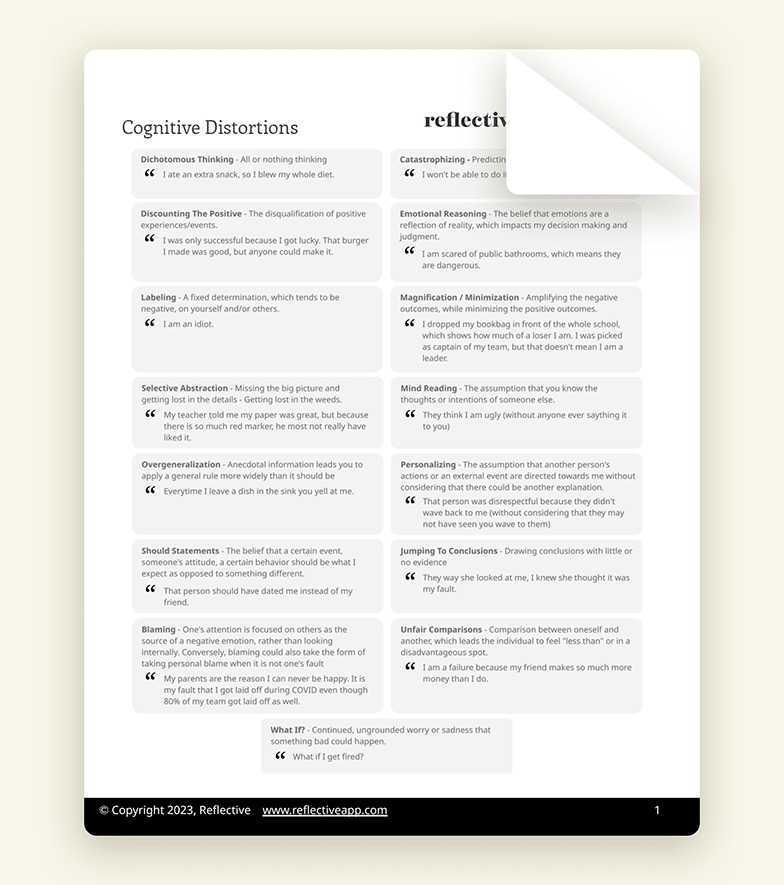Cognitive Distortions: Understanding and addressing negative thought patterns
Have you ever worked with a client struggling to break free from persistent, negative thought patterns that reinforce their anxiety, depression, or self-doubt? Cognitive distortions—irrational or exaggerated negative ways of thinking—are often at the root of these challenges. To help you support your clients, we’re offering a free Cognitive Distortions PDF worksheet, designed for therapists to share with clients as a practical tool in therapy.
Download it today and give your clients a clear, accessible guide to identifying and challenging their own cognitive distortions.

Table of Contents
- What are Cognitive Distortions?
- A Brief History of Cognitive Distortions
- How are Cognitive Distortions Used in Therapy?
- Treating Anxiety, Depression, OCD, and Trauma
- Apps can aid the therapy process
- Reflective: The Therapist-Facilitated App
- Get the free worksheet
What are Cognitive Distortions?
Cognitive distortions are biased ways of thinking that can distort an individual’s perception of reality. These distortions often occur automatically and reinforce negative emotions, leading to cycles of self-defeating behavior. Common examples include:
- All-or-Nothing Thinking: Viewing situations in black-and-white terms, with no middle ground.
- Catastrophizing: Expecting the worst possible outcome in any scenario.
- Personalization: Blaming oneself for events outside one’s control.
By becoming aware of these patterns, individuals can begin to challenge and reframe them, breaking free from the negative feedback loops they create.
A Brief History of Cognitive Distortions
The exploration of distorted thinking in mental health can be traced back to the pioneering work of Dr. Albert Ellis in the 1950s. Ellis developed Rational Emotive Behavior Therapy (REBT), one of the first cognitive-behavioral approaches to psychotherapy. He proposed that irrational beliefs, such as “I must always succeed” or “I can’t be happy unless everyone likes me,” were at the root of emotional distress. REBT emphasized identifying, disputing, and replacing these rigid, self-defeating beliefs with more rational and constructive ones. Ellis’s work laid a foundational understanding of the link between cognition, emotion, and behavior.
In the 1960s, Dr. Aaron T. Beck expanded on these ideas, taking a slightly different approach in developing Cognitive Behavioral Therapy (CBT). While Ellis’s REBT focused on disputing core irrational beliefs, Beck concentrated on the automatic, distorted thought patterns that arise in specific situations. He identified that individuals with depression, for example, often experience a “cognitive triad” of negative thoughts about themselves, their world, and their future. Beck’s structured methods for identifying, challenging, and reframing these automatic thoughts became a cornerstone of CBT and introduced the term cognitive distortions to the field.
Dr. David Burns further advanced the practical application of cognitive distortions in the 1980s, categorizing specific types in his book Feeling Good: The New Mood Therapy. Burns’s taxonomy of distortions, including catastrophizing, black-and-white thinking, and emotional reasoning, gave therapists and clients alike a clear, actionable framework for addressing distorted thought patterns. Together, Ellis, Beck, and Burns have profoundly shaped modern psychotherapy, making the identification and reframing of cognitive distortions a central component of evidence-based treatments for anxiety, depression, OCD, and trauma.
How are Cognitive Distortions Used in Therapy?
Therapists often incorporate work on cognitive distortions into evidence-based practices like CBT, Dialectical Behavior Therapy (DBT), and Acceptance and Commitment Therapy (ACT). This process typically involves:
- Awareness: Helping clients identify their distorted thinking patterns.
- Analysis: Encouraging clients to evaluate the evidence for and against these thoughts.
- Reframing: Supporting clients in replacing irrational beliefs with balanced, evidence-based perspectives.
This approach is especially helpful in treating anxiety, depression, OCD, and trauma, as distorted thoughts are often central to these conditions.
Treating Anxiety, Depression, OCD, and Trauma
Addressing cognitive distortions is a powerful way to help clients manage symptoms associated with anxiety and depression. For example:
- In OCD, addressing catastrophic thinking can reduce compulsive behaviors tied to irrational fears.
- In trauma, challenging distorted beliefs about blame and safety helps clients rebuild a sense of control and trust in themselves.
This work often extends beyond the therapy session, with homework exercises reinforcing insights and skills learned during treatment.

Apps can aid the therapy process
Modern tools make it easier than ever for therapists to extend the impact of therapy between sessions. Apps can provide structured exercises, mood trackers, and psychoeducation to help clients stay engaged. One such tool is Reflective, a therapist-facilitated mental health app.
Reflective: The Therapist-Facilitated App
Reflective empowers therapists by offering an integrated platform for delivering therapy homework and exercises, including the cognitive distortions worksheet. With tools like interactive mood trackers, thought records, and guided DBT/CBT exercises, Reflective helps clients stay on track between sessions. By reinforcing key concepts and improving compliance, it reduces drop-out rates and administrative burdens, enabling therapists to focus more on client care.


